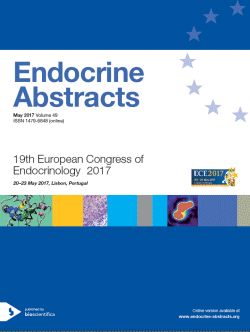
19th European Congress of Endocrinology
Lisbon,
Portugal
20 May 2017 - 23 May 2017
Oral Communications
Obesity
ea0049oc11.1 | Obesity | ECE2017
Role of Extracellular vesicles in the crosstalk between adipocytes and pancreatic beta-cells
Gesmundo Iacopo , Gargantini Eleonora , Favaro Enrica , Piemonti Lorenzo , Camussi Giovanni , Granata Riccarda
ea0049oc11.2 | Obesity | ECE2017
Three year prospective study in morbidly obese patients between longitudinal gastrectomy and gastric bypass based on a composite outcome combining weight loss efficacy and surgery related complications (PHRC SLEEVE K060213 / IDRCB2007-A00373-50)
Catheline Jean Marc , Fysekidis Marinos , Bendacha Yasmina , Bdeoui Najib , Raghavan Vidhya , Gerard Sophie , Portal Jean Jacques , Dbouk Rami , Fabre Jean Michel , Fourtanier Gilles , Gugenheim Jean , Huten Noel , Sodji Maxime , Msika Simon , Scotte Michel , Vicaut Eric , Cohen Regis
ea0049oc11.3 | Obesity | ECE2017
Interleukin-1 antagonism decreases cortisol levels in obese individuals
Urwyler Sandrine , Schutz Philipp , Ebrahimi Fahim , Donath Marc Y. , Christ-Crain Mirjam
ea0049oc11.4 | Obesity | ECE2017
Comparing effects of weight loss by liraglutide with intensive lifestyle modification on hepatic steatosis, inflammation and stiffness, and insulin resistance in obese Asians with non-alcoholic fatty liver disease (NAFLD)
Khoo Joan , Law Ngai-Moh , Hsiang John , Tan Jessica , Ang Tiing-Leong
ea0049oc11.5 | Obesity | ECE2017
Differentiating constitutional thinness from anorexia nervosa in DSM 5 era
Estour Bruno , Marouani Nesrine , Sigaud Torrance , Lang Francois , Fakra Eric , Diamonde Aurelie , Galusca Bogdan , Germain Natacha



